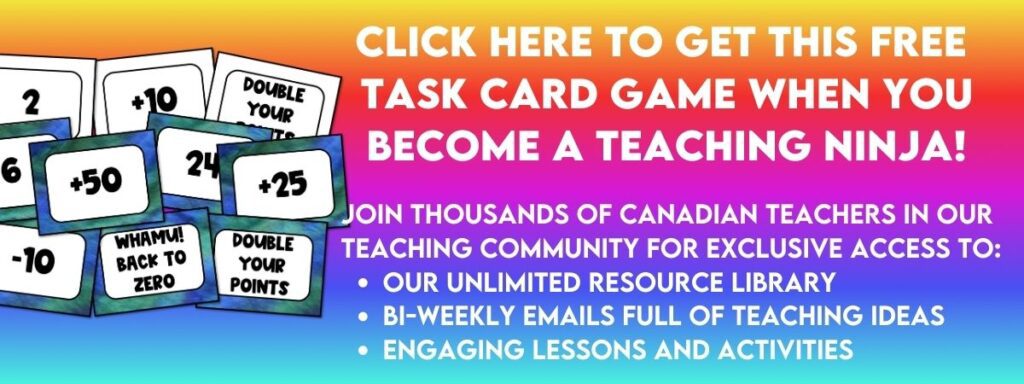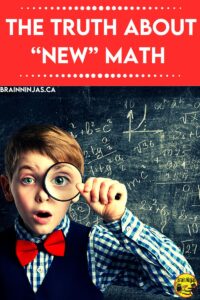
New math is ruining education. Or at least this is what we keep hearing people (like parents, the media, and politicians) say.
What is this “new math” of which you speak? I see the memes on Facebook and wonder, have I been teaching mathematics wrong? Has it changed? Did I miss an email about this?
Spoiler Alert: It’s Not New
There are a few reasons I find the concept of “new math” insulting. If you’re a seasoned teacher, you’ve probably heard parents complain about how this is confusing and time-consuming. If you’re a newer teacher, you’ll hear about it soon enough.
But the truth is math is not new.
I went to school in the 1980s. People complained about the “new math” back then. When my children went to school in the 2000s, I listened to fellow parents complain about it.
Not once since the beginning of school have we changed equations and numbers. They are the same.
What has changed is how our students need to interact with numbers. Remember when you were young and we were told we needed to learn estimation because you would need this skill in the grocery store? No one will be carrying a calculator around in their pocket. Well, that isn’t true anymore. Students can calculate anything anytime if they…
…know how the numbers interact
…know how the operations work.
…have problem-solving skills
…have developed personal strategies for solving equations in the real world
But it’s faster to do it this way
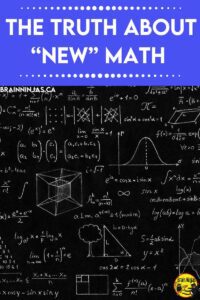
This is the number one complaint from parents. Yes, most algorithms are faster because you can do them faster. It’s the only way you’ve learned. If you only do something one way and you do it over and over again, it will be fast.
I had a little contest at a parent-teacher-student meeting to show a parent how well his child can multiply. Students in Grade 4 are required to multiply a 2-digit number by a 1-digit number. But, I challenged this student to multiply 5 digits by 5 digits using his personal strategy. He raced his father (an engineer), who used the traditional algorithm. They finished AT THE SAME TIME!
And, more importantly, my student could explain how the strategy he used worked, while the engineer parent couldn’t explain the purpose for each of the steps he used.
It demonstrated the importance of understanding the steps and this parent never complained again.
The strategy this student used was Lattice Multiplication. You can learn more about it in our post: Conquer Math With These Multiplication Strategies.
It doesn’t make sense to me
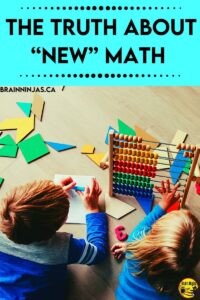
Parents struggle with not being able to explain concepts to their children. Teachers struggle with this, too. It has nothing to do with the math.
It’s the feeling of giving up control. As a parent, it’s terrifying that my child can do something that I don’t understand. (TikTok for example).
Compare it to technology in the classroom or at home. Teachers who fear technology tend to avoid it despite their students being able to use technology easily. That fear holds them back.
Math is like that at home. The idea that their child can do math in a way that is different than how they understand is scary – particularly in the younger grades when it’s supposed to be easy.
How I solved this problem: no homework. Our district has a policy for no homework, but even before that, I didn’t send home homework unless I was 1000% sure that the student wouldn’t need parental help.
I was so bad at it
We don’t mean to, but we often pass along our fears and worries to our children. Parents who were bad at math at school caused two different problems: they overhelp or underhelp. Neither is helpful.
Parents who are bad at math are usually quite vocal about it and cause their children to fear math (even when they aren’t struggling with it). Just talking about it as being this big scary subject is enough to derail progress.
Some of these parents try to help their children, but their misunderstandings about math sometimes get passed along. I once had a parent teach their daughter a shortcut to regroup numbers during subtraction. It took months to unlearn the “shortcut” that had her subtraction from the wrong side of the number.
The subtraction lessons started at home unnecessarily. This student subtracted numbers just fine before all the help.
Some parents undermine learning math by saying they don’t use most of what they learned in school. Also, not helpful when you’re trying to teach what is required.
I was good at math
Parents who are good at math can be a problem.
Case in point: my father.
My father is an excellent mathematician. His job requires him to use math I don’t even understand (well beyond the university level). Think Einstein or Big Bang Theory math.
But he is the worst teacher (I totally read him this paragraph and he agreed). I remember him screaming about the letter x in an algebra equation when I was in Grade 6. It left a lasting impression; in fact, I never understood what that x was for until I took a university math education course.
There was also a car left on the side of the road when I was sixteen, but that’s a story for another day.
Since my dad was so good at math, it was a hit to his ego to have a daughter who needed a math tutor through junior high and high school.
It turns out math skills are not inherited – good or bad. Anxiety about math is, however.
We don’t teach algorithms.

Well, that’s false because I do. I don’t usually start the first day of long multiplication with an algorithm because, let’s face it, it’s confusing. We work with numbers and procedures until students are ready to try the algorithm. This usually comes quickly when they understand place value and math facts and can complete equations with multiple steps.
We start with the concepts that will help students and move toward teaching the procedures. It is not one or the other.
One of the ways we teach the concepts is by using Interactive Math Notebooks. We have a great post to get you started: Things We Learned About Interactive Math Notebooks.
Try a Whole Year of Interactive Units
We also have math notebooks that contain an entire year of lessons available in our store. Each bundle includes all the math strands, lesson plans, templates, photographs of student examples, worksheets and assessments. We’ve included all the background information needed to teach each concept so you don’t have to search it out. That saves you so much time!
Grade 3 Interactive Math Unit
We have designed this to align with the Alberta, British Columbia and Saskatchewan outcomes, but we encourage you to look at it to see if it aligns with your province or territory. Find it in our TpT Store ($USD) or our BN Shop ($CAN).
Grade 4 Interactive Math Unit
We have designed this to align with the Alberta, British Columbia and Saskatchewan outcomes, but we encourage you to look at it to see if it aligns with your province or territory. Find it in our TpT Store ($USD) or our BN Shop ($CAN).
Grade 4/5 Interactive Math Unit
This set combines the two grade levels (but comes with a separate checklist for each grade level), so you can easily use it in a combined grade level classroom or differentiate it for your students. Everything you need to teach each concept is included to align with the Alberta, British Columbia and Saskatchewan outcomes. Find it in our TpT Store ($USD) or our BN Shop ($CAN).
Grade 5 Interactive Math Unit
We have designed this to align with the Alberta, British Columbia and Saskatchewan outcomes, but we encourage you to look at it to see if it aligns with your province or territory. Find it in our TpT Store ($USD) or our BN Shop ($CAN).
Grade 5/6 Interactive Math Unit
This set combines Grade 5 and 6 lessons together, making it easy to use in a combined grade classroom. It aligns with the Alberta, British Columbia and Saskatchewan outcomes. Find it in our TpT Store ($USD) or our BN Shop ($CAN).
Grade 6 Interactive Math Unit
We have designed this to align with the Alberta, British Columbia and Saskatchewan outcomes, but we encourage you to look at it to see if it aligns with your province or territory. Find it in our TpT Store ($USD) or our BN Shop ($CAN).
New math is only discovery.
Math class is not just filled with a bunch of students discovering how to do long division on their own while the teacher sits at a desk and plays solitaire on her computer.
Learning is all about discovery. That’s how our brains work. And, we learn things better when we discover the concept ourselves. Our brains actually create dendrites when we learn new things and those connections are stronger when we discover connections or new things.
Math class should include some components of self-discovery to help reinforce concepts and build independence, but this should be done with guidance and scaffolding. Good teachers naturally do this. This might be considered “new” because it doesn’t involve rows of students sitting in a math class completing a worksheet (a common practice for classrooms in the 20th century).
It looks like a lot of games.
Well, sometimes games make things fun. While I don’t believe everything has to be fun all the time, having a few games sprinkled in through the hard work is fun.
We assure parents that the games are rewards for learning a concept and that the game reinforces the learning.
One of our favourite games is Whamu!, which uses task cards. We can send you a copy or you can find it in our resource library. Basically, it’s a game where students have to answer a question and the points awarded could be good, bad or even help the other team.
Our blog post: The Trouble With Task Cards, might be able to help you out with more game ideas. If you use math worksheets, our post: Math Worksheet Games Your Students Will Crave should be useful.
Did you know: the term “new math” came in 1957 when the Russians launched Sputnik. In the United States, a push came in the education system to focus on more conceptual math over procedural math and thus the term “new math” came about.
So, “new math” is over sixty years old.
This is a letter I wrote in my head on the way home from school the other day.
Dear Guardians,
I have been asked several times about this “new math.” The answer is there is no NEW math. Math is math. Numbers are numbers.
People have been complaining about new math since I was in school during the 1980s. The media and politicians are quick to “inform” parents about this “new math.”.
Let me put your mind at rest and declare there is no new math.
But there is something different about the way we teach math.
Students are not taught to memorize everything by rote so they can rattle back answers. This was how math was taught in the past. When I was in school, we repeated steps, but I never really understood the concepts.
I teach your children to think about how numbers interact with each other, how to problem solve and how to develop their own personal strategies. They explain their thinking using math vocabulary. When they don’t “get it,” I teach it another way, using another strategy.
I know not being able to understand this “new math” that combines procedural knowledge and conceptual knowledge can be difficult as it’s not how we were taught to “do” math.
I ask for your patience with your child as they experience math. Soon enough, they will be able to teach you.
In the meantime, as your child is learning to develop his/her personal strategies, I ask that you don’t help by reteaching them the way you learned it yet. They are trying to develop their own personal strategy. That means taking the time to experiment and learn with different methods.
When they learn the traditional algorithm, I will be sure to let you know and you can practice together.
Thank you so much for being part of our learning team.
Yes, you can copy this letter for your own use.
Keep in mind that I have already built relationships with the parents of my students. This letter is not the first piece of communication they receive from me in a school year.
How do I help out the parents with “new math”?
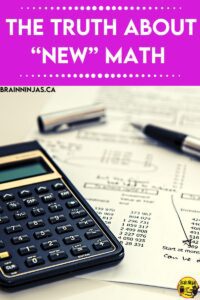
I post the videos I use with my students so parents can view them, too. By communicating with the parents of my students, it helps them understand “new math.”
When we have parents in the classroom, we allow them to learn and explore the same way students do. Sometimes, trying something themselves helps break down those barriers.
Communicate with parents whenever you can. And, explain to your students that their parents might have learned a different way. Change is good. It’s how we learned smoking is bad for you and seatbelts make you safer in a car.
What is your biggest beef with the “new math” myths? Leave us your thoughts in the comments below.

